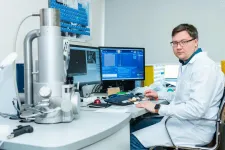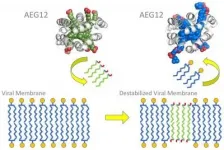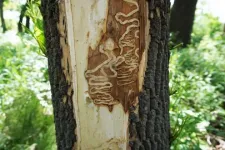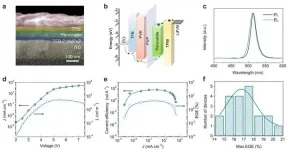(Press-News.org) People are different. New technology is good for patients and the healthcare system. But it could also expand the already significant health disparities in Norway and other countries.
"Women and men with higher education in Norway live five to six years longer than people with that only have lower secondary school education," says Emil Øversveen, a postdoctoral fellow at the Norwegian University of Science and Technology's (NTNU) Department of Sociology and Political Science.
He is affiliated with CHAIN, the Centre for Global Health Inequalities Research. The centre works to reduce social health inequalities worldwide.
Both Norwegian and international research shows that people with low occupational status, low income and less education have poorer health and live shorter lives than people higher up in the social hierarchy.
Øversveen has looked at whether new technology might be further increasing health disparities. His study compares differences between countries and between people within various countries.
"Vaccines are a health technology, too. The new knowledge can be used to understand why the COVID-19 vaccine is being unequally distributed around the world," says Øversveen.
We see that wealthy players like the USA, England and the EU countries are securing vaccines for themselves. These countries and people are buying their way to the front of the queue.
Norway has greater internal health inequities than many other European countries. These health discrepancies crop up in all age groups, including among children and young people.
The survey indicates that the differences have increased over time. Men's life expectancy between districts in Oslo has now grown to an eight-year difference.
In general, new health technology offers more opportunities for better treatment of patients and a more efficient health care system.
"For example, our smartwatch can send reports about our health directly to our doctor, and we can follow statistics and get recommendations on medication dosages on a phone app," Øversveen says.
These options are great for the folks who can benefit from them. But in practice, not everyone in Norway has equal access to the latest technology.
Øversveen has investigated how patients with diabetes use medical technology. At the same time, he has looked at how doctors and nurses decide who has access to the technology.
"Based on my qualitative research, I see that this patient group generally experiences that diabetes technology is difficult to access in the Norwegian health care system," says Øversveen.
But the technology isn't equally difficult for everyone. Patients' social characteristics and status play an important role when healthcare professionals prioritize who should be allowed to use the technology.
"The resourceful patients learn how they can 'buy their way in' as qualified, active and competent patients who 'deserve' the expensive technology," Øversveen says.
His work shows how the development, distribution and use of medical technology can contribute to creating and maintaining social health inequities in the public health care system.
"This is new and important knowledge about a large and global societal problem," says Øversveen.
Social inequalities in health care access exist in many countries, if not all. The study shows systematic links between health status and social position, causing a lot of people to lose out.
"Social health inequities are unfair and represent a loss for individuals, families and society," says Øversveen.
CHAIN is an interdisciplinary centre at NTNU that studies global health inequalities.
INFORMATION:
In the dry air and soil of Texas' Southern High Plains, improving soil health can be tough. We usually think of healthy soil as moist and loose with lots of organic matter. But this can be hard to achieve in this arid area of Texas.
Lindsey Slaughter, a member of the Soil Science Society of America, set out with her fellow researchers to test a solution that kills two birds with one stone. They put excess cow manure on these soils to see if they could make them healthier.
The team recently published their research in the Soil Science Society of America Journal.
"We know that planting perennial grasslands for cattle production can help protect and restore soil in semi-arid lands that are likely to erode and degrade from intense ...
The per-capita rates of new COVID-19 cases and COVID-19 deaths were higher in states with Democrat governors in the first months of the pandemic last year, but became much higher in states with Republican governors by mid-summer and through 2020, possibly reflecting COVID-19 policy differences between GOP- and Democrat-led states, according to a study led by researchers at the Johns Hopkins Bloomberg School of Public Health and the Medical University of South Carolina.
For their study, the researchers analyzed data on SARS-CoV-2-positive nasal swab tests, COVID-19 diagnoses, and COVID-19 ...
Immune cells specialize to ensure the most efficient defense against viruses and other pathogens. Researchers at the University of Basel have shed light on this specialization of T cells and shown that it occurs differently in the context of an acute and a chronic infection. This could be relevant for new approaches against chronic viral infections.
Researchers led by Professor Carolyn King of the University of Basel have developed a method to study the specialization of T cells in the context of infections. In the journal eLife, they report the different directions ...
The scientists of the National University of Science and Technology "MISIS" (NUST MISIS) being a part of an international team of researches managed to increase the capacity and extend the service life of lithium-ion batteries. According to the researchers, they have synthesized a new nanomaterial that can replace low-efficiency graphite used in lithium-ion batteries today. The results of the research are published in the Journal of Alloys and Compounds.
Lithium-ion batteries are widely used for household appliances from smartphones to electric vehicles. The charge-discharge cycle in such battery is provided by ...
As plastic debris weathers in aquatic environments, it can shed tiny nanoplastics. Although scientists have a good understanding of how these particles form, they still don't have a good grasp of where all the fragments end up. Now, researchers reporting in ACS' Environmental Science & Technology have shown experimentally that most nanoplastics in estuarine waters can clump, forming larger clusters that either settle or stick to solid objects, instead of floating on into the ocean.
There is a huge discrepancy between the millions of tons of plastic waste entering rivers and streams and the amount researchers have found in the oceans. As large pieces of plastic break apart into ...
The mosquito protein AEG12 strongly inhibits the family of viruses that cause yellow fever, dengue, West Nile, and Zika and weakly inhibits coronaviruses, according to scientists at the National Institutes of Health (NIH) and their collaborators. The researchers found that AEG12 works by destabilizing the viral envelope, breaking its protective covering. Although the protein does not affect viruses that do not have an envelope, such as those that cause pink eye and bladder infections, the findings could lead to therapeutics against viruses that affect millions of people around the world. The research ...
Throughout history, leather has been a popular material for clothes and many other goods. However, the tanning process and use of livestock mean that it has a large environmental footprint, leading consumers and manufacturers alike to seek out alternatives. An article in Chemical & Engineering News (C&EN), the weekly newsmagazine of the American Chemical Society, details how sustainable materials are giving traditional leather a run for its money.
Traditional leather goods are known for their durability, flexibility and attractive finish, with a global market worth billions, writes ...
Since its introduction, the emerald ash borer (EAB) has become the most devastating invasive forest insect in the United States, killing hundreds of millions of ash trees at a cost of hundreds of millions of dollars.
Now, new research from the University of Minnesota's Minnesota Invasive Terrestrial Plants and Pests Center (MITPPC) shows a possible path forward in controlling the invasive pest that threatens Minnesota's nearly one billion ash trees.
In a recent study published in Fungal Biology, MITPPC researchers identified various fungi living in EAB-infested trees -- a critical ...
Energy-efficient light-emitting diodes (LEDs) have been used in our everyday life for many decades. But the quest for better LEDs, offering both lower costs and brighter colours, has recently drawn scientists to a material called perovskite. A recent joint-research project co-led by the scientist from City University of Hong Kong (CityU) has now developed a 2D perovskite material for the most efficient LEDs.
From household lighting to mobile phone displays, from pinpoint lighting needed for endoscopy procedures to light source to grow vegetables in Space, LEDs ...
Hip fractures are serious, especially for the elderly. The operation can be a great strain, and 13 per cent of patients over the age of 70 do not survive 60 days after the fracture.
Their chance of survival may depend on how busy the surgeons are with other emergency procedures.
"When the operating room is busy, 20 per cent more of the patients die within 60 days after the operation," says Professor Johan Håkon Bjørngaard at the Norwegian University of Science and Technology's (NTNU) Department of Public Health and Nursing.
Surgeons can get especially busy during periods when the patient demand for surgery is high. In busy periods, hip fracture patients ...




